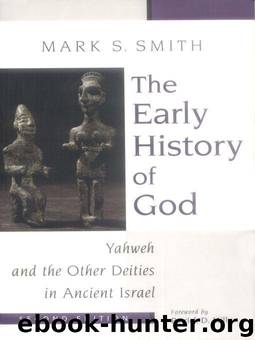The Early History of God: Yahweh and the Other Deities in Ancient Israel (Biblical Resource Series) by Smith Mark S

Author:Smith, Mark S. [Smith, Mark S.]
Language: eng
Format: epub
Publisher: Eerdmans Publishing Co - A
Published: 2010-04-12T04:00:00+00:00
CHAPTER 7
Postscript: Portraits of Yahweh
1. Processes Leading to Divine Portraiture in Israel
The development toward monotheism in Israel involved complex processes of convergence and differentiation of deities. The convergence of other deities, or at least their characteristics, toward Yahweh involved no single pattern. Polemic, for example, was directed against Baal, and to a lesser extent, asherah and the sun. Polemic was not only a negative factor in these cases, but involved a positive process at work as well, namely, the attribution of the positive characteristics of other deities to Yahweh. In some instances, polemic involved direct criticism of other deities, such as Baal, or cultic items, such as the asherah (2 Kings 21:7; 23:4), the asherim (2 Kings 23:14), and “the horses ... dedicated to the sun” and “the chariots of the sun” (2 Kings 23:11). Sometimes polemic assumed the form of negative depiction, as in the description of the priests bowing down before the sun in Ezekiel 8:16. Identification of Yahweh and another deity occasionally escaped polemic. Since El was no longer a religious threat in the first millennium, the positive identification of Yahweh-El was made without later accusations of idolatry.
This discussion has emphasized the process of addition of other deities or their traits to Yahweh. Yahweh is given the titles ’ēl or ba‘al, or is called “the Sun,” or is attributed their features. The word addition may also be applied to the incorporation of distinctly different attributes within Yahweh. Both solar and storm language are attributed to Yahweh in different passages and even within the same units. Similarly, Yahweh embodies both male and female, both El and Asherah. Addition is not infrequently accompanied by the feature of paradox. For example, 1 Kings 17-19 dramatizes how Yahweh, while controlling the natural power associated with Baal, transcends it as well. Yahweh is known in some way in both sun and storm, but at the same time transcends such manifestations. Where explicit criticism of another deity is involved, as in this case, paradox functions as a form of polemic. Another use of paradox again involves the application of gender. While Yahweh embodies the characteristics of mother and father, for example in the parental experience they convey, Yahweh also transcends the human finiteness inherent in both of them (Ps. 27:10). The paradox of natural manifestation is posed also by the biblical language of “seeing God,” an experience that was denied at times (Exod. 33:20, 23) and at other times affirmed (Num. 12:8; Isa. 6:1; Job 42:5; cf. Deut. 34:11; Pss. 11:7; 17:15; 27:4, 13; 42:3; 63:3).
A further process underlying the development of convergence and differentiation was the creation of new contexts for metaphorical expressions that functioned originally in polytheistic settings. Yahweh is called a “sun” (Ps. 84:12) and described as “rising” like the sun (Deut. 33:2). Although this solar attribution was thought to have been taken too literally (at least according to Ezek. 8:16), solar language functioned to convey aspects of Yahweh without reducing Yahweh to being the sun. In Genesis 1:14, the absorption of solar language works in another direction.
Download
This site does not store any files on its server. We only index and link to content provided by other sites. Please contact the content providers to delete copyright contents if any and email us, we'll remove relevant links or contents immediately.
| Buddhism | Christianity |
| Ethnic & Tribal | General |
| Hinduism | Islam |
| Judaism | New Age, Mythology & Occult |
| Religion, Politics & State |
Cecilia; Or, Memoirs of an Heiress — Volume 1 by Fanny Burney(31351)
Cecilia; Or, Memoirs of an Heiress — Volume 3 by Fanny Burney(30949)
Cecilia; Or, Memoirs of an Heiress — Volume 2 by Fanny Burney(30907)
The Secret History by Donna Tartt(16658)
Sapiens: A Brief History of Humankind by Yuval Noah Harari(13075)
Leonardo da Vinci by Walter Isaacson(11918)
The Radium Girls by Kate Moore(10915)
Sapiens by Yuval Noah Harari(4551)
The Wind in My Hair by Masih Alinejad(4427)
How Democracies Die by Steven Levitsky & Daniel Ziblatt(4413)
Homo Deus: A Brief History of Tomorrow by Yuval Noah Harari(4291)
Endurance: Shackleton's Incredible Voyage by Alfred Lansing(3855)
The Silk Roads by Peter Frankopan(3781)
Man's Search for Meaning by Viktor Frankl(3648)
Millionaire: The Philanderer, Gambler, and Duelist Who Invented Modern Finance by Janet Gleeson(3576)
The Rape of Nanking by Iris Chang(3526)
Hitler in Los Angeles by Steven J. Ross(3447)
The Motorcycle Diaries by Ernesto Che Guevara(3345)
Joan of Arc by Mary Gordon(3270)
